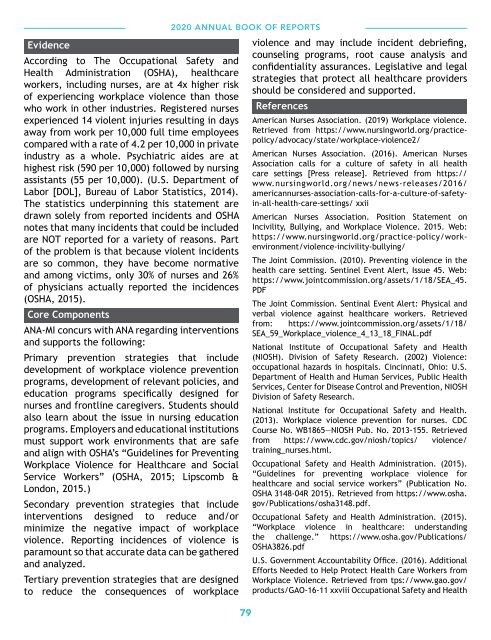ANA-Michigan - 2020 Annual Book of Reports
Create successful ePaper yourself
Turn your PDF publications into a flip-book with our unique Google optimized e-Paper software.
Evidence<br />
According to The Occupational Safety and<br />
Health Administration (OSHA), healthcare<br />
workers, including nurses, are at 4x higher risk<br />
<strong>of</strong> experiencing workplace violence than those<br />
who work in other industries. Registered nurses<br />
experienced 14 violent injuries resulting in days<br />
away from work per 10,000 full time employees<br />
compared with a rate <strong>of</strong> 4.2 per 10,000 in private<br />
industry as a whole. Psychiatric aides are at<br />
highest risk (590 per 10,000) followed by nursing<br />
assistants (55 per 10,000). (U.S. Department <strong>of</strong><br />
Labor [DOL], Bureau <strong>of</strong> Labor Statistics, 2014).<br />
The statistics underpinning this statement are<br />
drawn solely from reported incidents and OSHA<br />
notes that many incidents that could be included<br />
are NOT reported for a variety <strong>of</strong> reasons. Part<br />
<strong>of</strong> the problem is that because violent incidents<br />
are so common, they have become normative<br />
and among victims, only 30% <strong>of</strong> nurses and 26%<br />
<strong>of</strong> physicians actually reported the incidences<br />
(OSHA, 2015).<br />
Core Components<br />
<strong>ANA</strong>-MI concurs with <strong>ANA</strong> regarding interventions<br />
and supports the following:<br />
Primary prevention strategies that include<br />
development <strong>of</strong> workplace violence prevention<br />
programs, development <strong>of</strong> relevant policies, and<br />
education programs specifically designed for<br />
nurses and frontline caregivers. Students should<br />
also learn about the issue in nursing education<br />
programs. Employers and educational institutions<br />
must support work environments that are safe<br />
and align with OSHA’s “Guidelines for Preventing<br />
Workplace Violence for Healthcare and Social<br />
Service Workers” (OSHA, 2015; Lipscomb &<br />
London, 2015.)<br />
Secondary prevention strategies that include<br />
interventions designed to reduce and/or<br />
minimize the negative impact <strong>of</strong> workplace<br />
violence. Reporting incidences <strong>of</strong> violence is<br />
paramount so that accurate data can be gathered<br />
and analyzed.<br />
Tertiary prevention strategies that are designed<br />
to reduce the consequences <strong>of</strong> workplace<br />
<strong>2020</strong> ANNUAL BOOK OF REPORTS<br />
79<br />
violence and may include incident debriefing,<br />
counseling programs, root cause analysis and<br />
confidentiality assurances. Legislative and legal<br />
strategies that protect all healthcare providers<br />
should be considered and supported.<br />
References<br />
American Nurses Association. (2019) Workplace violence.<br />
Retrieved from https://www.nursingworld.org/practicepolicy/advocacy/state/workplace-violence2/<br />
American Nurses Association. (2016). American Nurses<br />
Association calls for a culture <strong>of</strong> safety in all health<br />
care settings [Press release]. Retrieved from https://<br />
www.nursingworld.org/news/news-releases/2016/<br />
americannurses-association-calls-for-a-culture-<strong>of</strong>-safetyin-all-health-care-settings/<br />
xxii<br />
American Nurses Association. Position Statement on<br />
Incivility, Bullying, and Workplace Violence. 2015. Web:<br />
https://www.nursingworld.org/practice-policy/workenvironment/violence-incivility-bullying/<br />
The Joint Commission. (2010). Preventing violence in the<br />
health care setting. Sentinel Event Alert, Issue 45. Web:<br />
https://www.jointcommission.org/assets/1/18/SEA_45.<br />
PDF<br />
The Joint Commission. Sentinal Event Alert: Physical and<br />
verbal violence against healthcare workers. Retrieved<br />
from: https://www.jointcommission.org/assets/1/18/<br />
SEA_59_Workplace_violence_4_13_18_FINAL.pdf<br />
National Institute <strong>of</strong> Occupational Safety and Health<br />
(NIOSH). Division <strong>of</strong> Safety Research. (2002) Violence:<br />
occupational hazards in hospitals. Cincinnati, Ohio: U.S.<br />
Department <strong>of</strong> Health and Human Services, Public Health<br />
Services, Center for Disease Control and Prevention, NIOSH<br />
Division <strong>of</strong> Safety Research.<br />
National Institute for Occupational Safety and Health.<br />
(2013). Workplace violence prevention for nurses. CDC<br />
Course No. WB1865—NIOSH Pub. No. 2013-155. Retrieved<br />
from https://www.cdc.gov/niosh/topics/ violence/<br />
training_nurses.html.<br />
Occupational Safety and Health Administration. (2015).<br />
“Guidelines for preventing workplace violence for<br />
healthcare and social service workers” (Publication No.<br />
OSHA 3148-04R 2015). Retrieved from https://www.osha.<br />
gov/Publications/osha3148.pdf.<br />
Occupational Safety and Health Administration. (2015).<br />
“Workplace violence in healthcare: understanding<br />
the challenge.” https://www.osha.gov/Publications/<br />
OSHA3826.pdf<br />
U.S. Government Accountability Office. (2016). Additional<br />
Efforts Needed to Help Protect Health Care Workers from<br />
Workplace Violence. Retrieved from tps://www.gao.gov/<br />
products/GAO-16-11 xxviii Occupational Safety and Health

















